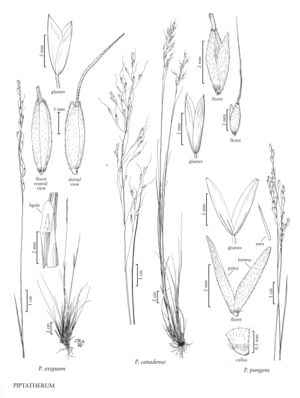Difference between revisions of "Piptatherum pungens"
FNA>Volume Importer |
imported>Volume Importer |
||
| (4 intermediate revisions by 2 users not shown) | |||
| Line 7: | Line 7: | ||
|synonyms={{Treatment/ID/Synonym | |synonyms={{Treatment/ID/Synonym | ||
|name=Oryzopsis pungens | |name=Oryzopsis pungens | ||
| − | |authority= | + | |authority= |
| + | |rank=species | ||
}} | }} | ||
|hierarchy=Poaceae;Poaceae subfam. Pooideae;Poaceae tribe Stipeae;Piptatherum;Piptatherum pungens | |hierarchy=Poaceae;Poaceae subfam. Pooideae;Poaceae tribe Stipeae;Piptatherum;Piptatherum pungens | ||
| Line 19: | Line 20: | ||
-->{{Treatment/Body | -->{{Treatment/Body | ||
| − | |discussion=<p>Piptatherum pungens grows in sandy to rocky soils and open habitats, from southern Yukon Territory across Canada to the Great Lakes region and eastern Pennsylvania, and, as a disjunct, in the western Great Plains and the southern Rocky Mountains. Its apparent absence from Idaho and Montana, and almost complete absence from Wyoming, is puzzling. The awns of P. pungens fall off so rapidly that it is sometimes mistaken for Milium or Agrostis, but the only perennial species of Milium in the Flora region has leaf blades 8-17 mm wide, and no species of Agrostis has such stiff lemmas and well-developed paleas. Its deciduous, shorter awns distinguish it from P. canadense.</p> | + | |discussion=<p><i>Piptatherum pungens</i> grows in sandy to rocky soils and open habitats, from southern Yukon Territory across Canada to the Great Lakes region and eastern Pennsylvania, and, as a disjunct, in the western Great Plains and the southern Rocky Mountains. Its apparent absence from Idaho and Montana, and almost complete absence from Wyoming, is puzzling. The awns of <i>P. pungens</i> fall off so rapidly that it is sometimes mistaken for <i>Milium</i> or <i>Agrostis</i>, but the only perennial species of <i>Milium</i> in the Flora region has leaf blades 8-17 mm wide, and no species of <i>Agrostis</i> has such stiff lemmas and well-developed paleas. Its deciduous, shorter awns distinguish it from <i>P. canadense</i>.</p> |
|tables= | |tables= | ||
|references= | |references= | ||
| Line 28: | Line 29: | ||
-->{{#Taxon: | -->{{#Taxon: | ||
name=Piptatherum pungens | name=Piptatherum pungens | ||
| − | |||
|authority=(Torr.) Dorn | |authority=(Torr.) Dorn | ||
|rank=species | |rank=species | ||
| Line 35: | Line 35: | ||
|basionyms= | |basionyms= | ||
|family=Poaceae | |family=Poaceae | ||
| − | |illustrator=Cindy Roché | + | |illustrator=Cindy Roché;Hana Pazdírková |
| + | |illustration copyright=Utah State University | ||
|reference=None | |reference=None | ||
|publication title= | |publication title= | ||
|publication year= | |publication year= | ||
|special status= | |special status= | ||
| − | |source xml=https:// | + | |source xml=https://bitbucket.org/aafc-mbb/fna-data-curation/src/200273ad09963decb8fc72550212de541d86569d/coarse_grained_fna_xml/V24/V24_198.xml |
|subfamily=Poaceae subfam. Pooideae | |subfamily=Poaceae subfam. Pooideae | ||
|tribe=Poaceae tribe Stipeae | |tribe=Poaceae tribe Stipeae | ||
Latest revision as of 16:22, 11 May 2021
Plants cespitose, not rhizomatous. Culms 10-90 cm, usually glabrous, occasionally puberulent beneath the nodes; basal branching intravaginal. Leaves basally concentrated; sheaths smooth or somewhat scabrous; ligules 0.5-2.5 mm, truncate to acute; blades (6)18-45 cm long, 0.5-1.8 mm wide, flat to convolute, abaxial surfaces scabridulous to scabrous, adaxial surfaces scabrous. Panicles 4-6 cm, lower nodes with 1-2 primary branches; branches 0.8-4 cm, straight, usually strongly ascending, ascending to divergent at anthesis. Glumes subequal, 3.5-4.5 mm long, 1.4-2 mm wide, from 1 mm shorter than to slightly exceeding the florets, ovate, usually 1-veined, sometimes 3-5-veined near the base, apices rounded or acute; florets 3-4 mm, dorsally compressed; calluses 0.2-0.3 mm, rounded, hairy, disarticulation scars circular; lemmas evenly pubescent, margins not overlapping at maturity; awns 1-2 mm, straight, slightly twisted, caducous, often absent even from immature florets; paleas equaling or almost equaling the lemma lobes, similar in texture and pubescence to the lemmas; anthers 0.8-1.8 mm, usually not penicillate; ovaries with a conelike extension bearing a 2-branched style. Caryopses about 1.8 mm long, about 0.9 mm wide; hila linear, 9/10 as long as to equaling the caryopses. 2n = 22, 24.
Discussion
Piptatherum pungens grows in sandy to rocky soils and open habitats, from southern Yukon Territory across Canada to the Great Lakes region and eastern Pennsylvania, and, as a disjunct, in the western Great Plains and the southern Rocky Mountains. Its apparent absence from Idaho and Montana, and almost complete absence from Wyoming, is puzzling. The awns of P. pungens fall off so rapidly that it is sometimes mistaken for Milium or Agrostis, but the only perennial species of Milium in the Flora region has leaf blades 8-17 mm wide, and no species of Agrostis has such stiff lemmas and well-developed paleas. Its deciduous, shorter awns distinguish it from P. canadense.
Selected References
None.
